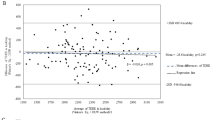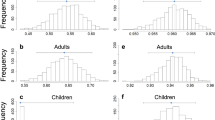Abstract
Objective:
To compare energy expenditure (EE) measured by doubly labeled water (DLW) with other measures, both physical and based on subjective questionnaires.
Design:
A comparison of methods in a stratified sample of adult volunteers.
Setting:
The feeding behaviour suite (FBS) at the Rowett Research Institute, Aberdeen.
Subjects:
A total of 59 subjects, stratified for age, sex and body mass index (BMI).
Interventions:
EE was assessed by DLW (validated using measurements of energy balance), heart rate monitor (HRM), activity monitor (Caltrac), 24-h physical activity diary (PAD) and 7-day physical activity recall. Energy intake was assessed using covert (investigator-weighed) food intake (EI). Data were collected over a 12-day period of residence in the Rowett's FBS.
Results:
No methods correlated highly with physical activity assessed by DLW. Physical methods correlated more closely than did subjective recording. All methods (except EI) significantly underestimated EE, estimated by DLW. There were no significant differences in association between methods and sex, age, BMI or fat-free mass.
Conclusion:
EE is difficult to measure precisely or accurately with current approaches but physical methods are slightly better than subjective accounts.
This is a preview of subscription content, access via your institution
Access options
Subscribe to this journal
Receive 12 print issues and online access
$259.00 per year
only $21.58 per issue
Buy this article
- Purchase on Springer Link
- Instant access to full article PDF
Prices may be subject to local taxes which are calculated during checkout




Similar content being viewed by others
References
Anonymous (1997). Seven-day physical activity recall. Med. Sci. Sports Exerc. 29,Suppl, S89–S103. Primary reference: Sallis JF, Haskell W and Wood PD (1985): Physical activity assessment methodology in the Five-City Project. Am. J. Epidemiol. 121, 91–106.
Black AE, Prentice AM, Coward WA (1986). Use of food quotients to predict respiratory quotients for the doubly-labelled water method of measuring energy expenditure. Hum Nutr: Clin Nutr 40, 381–391.
Bland JM, Altman DG (1986). Statistical methods for assessing agreement between two methods of clinical measurement. Lancet 1, 307–310.
Bratteby L-E, Sandhagen B, Fan H, Samuelson G (1997). A 7-day activity diary for assessment of daily energy expenditure validated by the doubly labelled water method in adolescents. Eur J Clin Nutr 51, 585–591.
Ceesay SM, Prentice AM, Day KC, Murgatroyd PR, Goldburg GR, Scott W et al (1989). The use of heart rate monitoring in the estimation of energy expenditure: a validation study using indirect whole-body calorimetry. Br J Nutr 61, 175–186.
Coward WA, Cole TJ (1991). The doubly-labeled water method for the measurement of energy expenditure in humans: Risks and benefits. In: RG Whitehouse and A Prentice (eds). New Techniques in Nutritional Research. Academic Press: New York. pp 150–151.
Coward WA, Prentice AM (1985). Isotope method for the measurement of carbon-dioxide production rate in man. Am J Clin Nutr 41, 659–661.
Davidson L, McNeill G, Haggarty P, Smith JS, Franklin MF (1997). Free-living energy expenditure of adult men assessed by continuous heart-rate monitoring and doubly-labelled water. Br J Nutr 78, 695–708.
De Abajo S, Larriba R, Marquez S (2001). Validity and reliability of the Yale Physical Activity Survey in Spanish elderly. J Sports Med Phys Fitness 41, 479–485.
Eisenmann JC, Milburn N, Jacobsen L, Moore SJ (2002). Reliability and convergent validity of the Goldin Leisure-Time Exercise Questionnaire in rural 5th grade school children. J Hum Mov Stud 43, 135–149.
Holland B, Welch AA, Unwin ID, Buss DH, Paul AA, Southgate DAT (1991). McCance and Widdowson's The Composition of Foods. The Royal Society of Chemistry: Cambridge.
Irwin ML, Ainsworth BE, Conway JM (2001). Estimation of energy expenditure from physical activity measures: determinants of accuracy. Obes Res 9, 517–525.
Leenders NYJM, Sherman WM, Nagaraja HN, Kien CL (2001). Evaluation of methods to assess physical activity in free-living conditions. Med Sci Sports Exerc 33, 1233–1240.
Midwood AJ, Haggarty P, Milne E, McGaw BA (1992). Factors affecting the analysis of 18O-enriched aqueous samples when using CO2 equilibration in Vacutainers. Appl Radiat Isot 43, 1341–1347.
O'Reilly LM (2001). Mis-reporting of food intake by UK adults. Ph.D. thesis. University of Ulster at Coleraine, UK.
Paul A, Southgate D (1978). McCance and Widdowson's The Composition of Foods. HMSO: London.
Racette SB, Schoeller DA, Kushner RF (1995). Comparison of heart rate and physical activity recall with doubly labeled water in obese women. Med Sci Sports Exerc 27, 126–133.
Richardson MT, Ainsworth BE, Jacobs DR, Leon AS (2001). Validation of the Stanford 7-day recall to assess habitual physical activity. Ann Epidemiol 11, 145–153.
Rothenberg E, Bosaeus I, Lernfelt B, Landahl S, Steen B (1998). Energy intake and expenditure: validation of a diet history by heart rate monitoring, activity diary and doubly labeled water. Eur J Clin Nutr 52, 832–838.
Schoeller DA, van Santen E (1982). Measurement of energy expenditure in humans by doubly labelled water. J Appl Physiol 53, 955–959.
Scrimgeour CM, Rollo MM, Mudambo SMKT, Handley LL, Prosser SJ (1993). A simplified method for deuterium/ hydrogen isotope ratio measurements on water samples of biological origin. Biol Mass Spectrom 22, 383–387.
Starling RD, Matthews DE, Ades PA, Poehlman ET (1999). Assessment of physical activity in older individuals: a doubly labeled water study. J Appl Physiol 86, 2090–2096.
Staten LK, Taren DL, Howell WH, Tobar M, Poehlman ET, Hill A et al (2001). Validation of the Arizona Activity Frequency Questionnaire using doubly labeled water. Med Sci Sports Exerc 33, 1959–1967.
Stubbs RJ, Hughes DA, Johnstone AM, Whybrow S, Horgan GW, King N et al (2004). Rate and extent of compensatory changes in energy intake and expenditure in response to altered exercise and diet composition in humans. Am J Physiol Regul Integr Comp Physiol 286, R350–R358.
Stubbs RJ, O'Reilly L, Fuller Z, Horgan G, Meher C, Deary I et al. (2001). Detecting and modeling mis-reporting of food intake in adults. Project Report N08001 Food Standards Agency, London.http://www.food.gov.uk/science/research/researchinfo/nutritionresearch/dietarynutrientsresearch/n08programme/n08projectlist/n08001/.
Weir JB, De V (1949). New methods for calculating metabolic rate with special reference to protein metabolism. J Physiol (London) 109, 1–9.
Westerterp KR (1999). Assessment of physical activity level in relation to obesity: current evidence and research issues. Med Sci Sports Exerc 31, S522–S525.
Acknowledgements
This work was funded by the Food Standards Agency (FSA).
Author information
Authors and Affiliations
Corresponding author
Additional information
Contributors: ZF conducted the study, carried out data analysis and interpretation, and wrote the manuscript. GH performed the statistical analysis and assisted with manuscript revision. LMO conducted the study and carried out data analysis. PR provided input on the DLW data analyses. EM conducted DLW sample analysis. RJS was the project leader and was involved in the study design, data interpretation and assisted with the manuscript revision. The authors declared that no conflict of interest existed.
Rights and permissions
About this article
Cite this article
Fuller, Z., Horgan, G., O'Reilly, L. et al. Comparing different measures of energy expenditure in human subjects resident in a metabolic facility. Eur J Clin Nutr 62, 560–569 (2008). https://doi.org/10.1038/sj.ejcn.1602739
Received:
Revised:
Accepted:
Published:
Issue Date:
DOI: https://doi.org/10.1038/sj.ejcn.1602739
Keywords
This article is cited by
-
Activity energy expenditure is an independent predictor of energy intake in humans
International Journal of Obesity (2019)
-
Biological and psychological mediators of the relationships between fat mass, fat-free mass and energy intake
International Journal of Obesity (2019)
-
A systematic literature review of reviews on techniques for physical activity measurement in adults: a DEDIPAC study
International Journal of Behavioral Nutrition and Physical Activity (2018)
-
Validity of activity monitors in health and chronic disease: a systematic review
International Journal of Behavioral Nutrition and Physical Activity (2012)
-
Urinary C-peptide Is Not an Accurate Bioindicator of Energy Balance in Humans
Obesity (2012)



